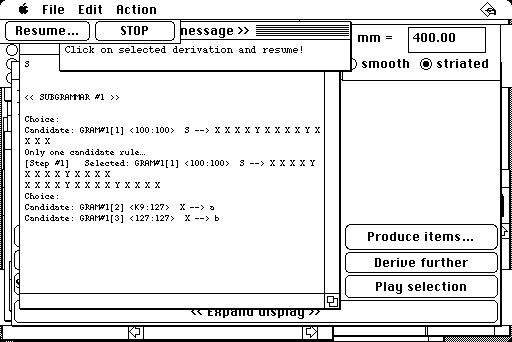12.
Step computation
So
far we have seen how BP2 can be used to produce items randomly. BP2 makes
decisions on candidate rules and positions of derivation following a (pre-set)
pseudo-random sequence generated by the computer, as indicated in §5.1.
Another
way of controlling computation is to make stepwise decisions on candidate
rules. This becomes possible by selecting option "Choose candidate rul
e"
(see Fig.31 infra). Now BP2 will display computation steps along with the
rules used, prompting the user to click "Resume" at each step. When there are
several candidate rules the user is prompted to mark the selected one.
 Fig.31
Prompting the user for a rule
Fig.31
Prompting the user for a rule
To
select a rule just click on it, then click "Resume" or type cmd-r. If the
"Resume-Undo-Stop" window disappears you may click the upper bar (the drag
region) of the "Trace" window to bring it to front.
In
the example below rule "X --> a" has been selected:
 Fig.32
Selecting a candidate rule
Fig.32
Selecting a candidate ruleIf
your decision leads to an unacceptable solution you may undo the computation
typing cmd-z or selecting "Und
o"
in the "Action" menu. Undoing permits to backtrack as far as possible.
At
any stage of the computation you may want to stop and save current choices.
Click button "Save decision
s".
The current grammar is saved along with decisions. Decisions include the
index of the subgrammar, the index of the selected rule and the position of the
current derivation.
When
loading a decision fil
e
(clicking "Load decision
s")
BP2 first checks whether or not the grammar currently in memory is the same one
as the grammar to which decisions were refering. (BP2 remembers the date and
time at which the grammar was compiled.) If the grammar has changed it
suggests to delete the current grammar and replace it with the version saved
along with the decision file.
Forcing
a set of decisions on a grammar which is no longer compatible may produce
unpredictable results
including
crashing the system
.
Once
a decision fil
e
is loaded, select "Step-by-step comput
e"
and click "Repeat computatio
n".
When reaching the point at which the production had been interrupted, the user
is prompted to continue making his/her own decisions.

